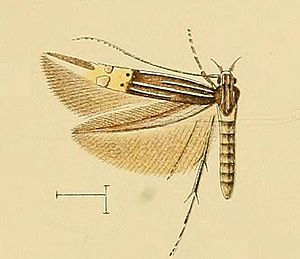Cosmopterix coryphaea
| Cosmopterix coryphaea | ||||||||||||
|---|---|---|---|---|---|---|---|---|---|---|---|---|

Cosmopterix coryphaea |
||||||||||||
| Systematics | ||||||||||||
|
||||||||||||
| Scientific name | ||||||||||||
| Cosmopterix coryphaea | ||||||||||||
| Walsingham , 1908 |
Cosmopterix coryphaea is a butterfly ( moth ) from the family of cosmopterigidae (Cosmopterigidae).
features
The moths reach a wingspan of 8 to 10 millimeters. The head is olive brown, has a white center line and two white side lines. The antennae are light brown and have a white line that extends from the base to behind the center of the antennae. The two subapical, white sections consist of two segments separated by two brown segments. The tip of the antenna is white. The thorax is olive brown and has a white center line. The tegulae are light brown and have a white line inside. The forewings are olive brown and marked with five white lines in the basal region . The costal line extends from 1/4 of the forewing length to the yellow band. The subcostal line extends from the base of the wing up to 1/3 of the fore wing length and curves slightly away from the costalader in the middle . The middle line begins at the base of the wing and almost reaches the yellow band. The subdorsal line begins at 1/4 of the fore wing length and extends to the yellow band. It curves away from the inner edge of the wing. The dorsal line runs from the wing base up to 1/4 of the forewing length. In the middle of the wing there is a wide, yellow band, which is extended in the middle towards the apex . Proximally it has a small extension in the middle. Within the yellow band there are four raised, silvery, shiny spots. Two are on the inner edge and are surrounded by a black point on the outside. The costal spot is slightly larger than the dorsal spot. There are two spots in the middle of the yellow band, here the dorsal spot is about twice as large as the costal spot. Both are outlined in brown on the inside. A white costal spot lies on the outer edge of the silvery spot. There is a white apical line at the apex. The fringed scales are ocher gray. The hind wings are brownish gray. The abdomen is dorsally ocher.
In the male, the right brachium is club-shaped and has tapering appendages in the middle. It is about four times as long as the left brachium. The blades are almost square. The upper edge is concave , the lower edge is slightly convex , the caudal edge is almost straight. The valvellae are short and strong and bent at right angles in the middle. They taper apically and have a blunt tip. The aedeagus is can-shaped. The rear part widens slightly distally and has a flange ventrally . The genital armature of the males differs from Cosmopterix pararufella by the club-shaped and sharply pointed right brachium, the square-shaped valves and the strong valvellae.
In females, the rear edge of the 7th sternite is arched. The 7th segment is slightly wider than it is long. The ostium is rounded and provided with a semicircular sclerotization. The sterigma is large and oval around the ostium. Distally it has a long, narrow process that ends in a bulbous point. The ductus bursae is slightly shorter than the corpus bursae and has a few sclerotized spots distally . The corpus bursae is oval and has two circular signs that are provided with an anchor-shaped sclerotization.
Similar species
Cosmopterix coryphaea is similar to Cosmopterix pararufella , but differs in the genital armature.
distribution
Cosmopterix coryphaea is native to southern Europe ( Crete , Croatia , Cyprus , Greece , Italy , Sicily ), North Africa , the Middle East and the Canary Islands .
biology
The caterpillars develop on reeds ( Phragmites australis ) and mine in the leaves in the same way as Cosmopterix liengiella . The caterpillars pupate in the mine. Butterflies were collected from February to June.
Systematics
The following synonyms are known:
- Cosmopteryx coryphaea Walsingham , 1908
- Cosmopteryx donatellae Mariani , 1932
- Cosmopteryx formosa Blackbird , 1935
- Cosmopteryx coryphae Agenjo , 1952
supporting documents
- ↑ a b c d e J. C. Koster, S. Yu. Sinev: Momphidae, Batrachedridae, Stathmopodidae, Agonoxenidae, Cosmopterigidae, Chrysopeleiidae . In: P. Huemer, O. Karsholt, L. Lyneborg (eds.): Microlepidoptera of Europe . 1st edition. tape 5 . Apollo Books, Stenstrup 2003, ISBN 87-88757-66-8 , pp. 119 (English).
- ↑ Cosmopterix coryphaea in Fauna Europaea. Retrieved January 16, 2012